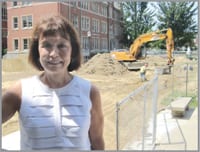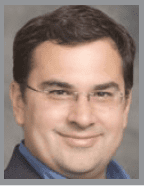Learning Curves Elms Sciences Center Will Take an Integrated Approach
David Berkowitz-Gosselin called it “the most pleasing noise I’ve ever heard.”
He was referring to the din of jackhammers, generators, and other construction equipment as work continues on the new $13.5 million, 22,000-square-foot Center for Natural and Health Sciences on the Elms College campus, a facility that is prompting school administrators to wear out the phrase ’state-of-the art.’
The expansion initiative, which has been more than a decade in the making, will take an integrated approach to educating students in the health and natural sciences fields, said Berkowitz-Gosselin, chair of the Division of Natural Sciences, Mathematics, and Technology, and associate professor of Computer Information Technology at Elms. And in so doing, it should facilitate efforts at the school to increase enrollment in many programs.
It will also enable the college to help meet the growing need for specialists in a number of health care professions, especially nursing, said Kathleen Scoble, director and chair of the Division of Nursing at Elms.
She told HCN that as the Baby Boom generation ages (the average age of members of that demographic is now 57) and individuals retire, the health care industry will face the daunting challenge of filling those positions and new ones demanded by an aging population that will require more health care services.
Meanwhile, more vocations within the health care sector are demanding advanced degrees, said Scoble, citing, as just one example, a new Nursing Practitioner (NP) doctorate program at Elms that the new science center will help make reality.
“Nursing is moving in the direction of other health professionals like pharmacy, psychology, physical therapy and audiology,”she explained, “where their advanced practitioners are prepared at the doctoral level.
“There is such a demand for advance-practice nurses and NPs because the changing demands of our country’s complex health care environment requires the highest level of knowledge, practice, and expertise, particularly in the areas of primary care,” she continued. “In order for us to expand access to primary care, advance practice nurses play a key role.”
For this issue, HCN takes an in-depth look at the new sciences center at Elms, and how it is expected to help the school reach the proverbial next level, while also better preparing students for the workforce they will soon be entering.
School of Thought
Ground was broken for the new science center on June 2, an event that culminated more than 10 years of planning and fund-raising for the facility, said Dr. Walter Breau, vice president of Academic Affairs for the college.
He told HCN that the facility, scheduled to open for the spring semester in 2014, will feature two state-of-the-art patient-simulation labs, used in the training of many health care professionals, especially nurses, and possibly a third in the future. These labs allow instructors to simulate (hence the name) patient conditions that students will encounter in the field, essentially allowing them to gain real-world experience, but in the classroom, rather than the emergency room.
The center will also house eight advanced laboratories, as well as research, clinical, and classroom space for existing programs in computer science, biology, chemistry, and nursing.
With the new facilities — programs are currently housed in Berchmans Hall, the school’s main administration and academic building — Elms leaders are projecting as much as a 40{06cf2b9696b159f874511d23dbc893eb1ac83014175ed30550cfff22781411e5} increase in overall enrollment over the next several years; the current student population is just over 1,300.
That’s a sizable jump, said Elms President Sr. Mary Reap, adding that the school is already looking at the potential impact from such a spike. “We are in the planning stage regarding additional housing; it’s just a consequence of growth,” she explained, ” a ripple effect.”
That ripple will start with new and expanded programs in health and natural sciences, including the NP initiative, creation of which reflects changes in the health care field and recognized need in the industry for individuals with advanced degrees, said Scoble.
She told HCN that Elms currently offers two masters programs in nursing, one focused on management and the other on education. But an NP program is necessary, she continued, to not only help train the next generation of nurses, but also to better enable the health care community to adjust to another problem — the widespread retirement of primary care physicians.
Scoble specifically references the American Association of Colleges of Nursing (AACN), which she descibed as a voice for America’s baccalaureate-and advanced-degree nursing education.
“They (AACN) voted to endorse schools to implement doctoral-level preparation for the nurse practitioner program by the year 2015, so most colleges, like Elms, who are developing new NP programs are seeking to develop the Doctor of Nursing practice, as opposed to a master’s program.”
In 2001, a report prepared by the ACCN predicted the current shortage of nurses, which has resulted from demographic pressures influencing both supply and demand. The report, Nursing Workforce: Emerging Nurse Shortages Due to Multiple Factors, stated that the future demand for nurses would increase dramatically as baby boomers reach their 60s and beyond.
To underscore her point, Scoble referenced a recent article in a Berkshire County publication, which reported that due to the retirement of a few primary care physicians in that area, residents were scrambling to find new doctors. Such reports are becoming increasingly common, and not just in Massachusetts, she added.
“This is one of the reasons why health systems are looking more and more toward advanced-practice nurses to bridge that gap,” Scoble explained, adding that, in order to fill those gaps, doctoral-level nurses, as well as the instructors to teach them, will have to be trained in all areas of technology that touch the health care field.
Indeed, to fully prepare students for the changing workplace they will encounter, the new science center will feature an integrated approach to education, said those we spoke with.
More specifically, it will prepare students for what they’ll face in their chosen field of health care, said Berkowitz-Gosselin, while also enabling them to take full advantage of ever-advancing telecommunications technology.
As he gave HCN a tour of current facilities in Berchmans Hall, where his computer labs are now located, Berkowitz-Gosselin was preparing for an educational technology class for the nurse educator-track.
“What I’m teaching them is how to use technology within the classroom,” he explained, “so for the nurses that are going to be the developmental coordinators for their future staff, not everybody might be able to make a meeting, so I’m showing them how to film their meetings and then post them online.”
“For workshops, I’m teaching them how to do interactive quizzes through a Moodle classroom system,” he continued, adding that many nursing students are seeking new careers, and some of them haven’t been in a classroom in 20 years and thus need to fully understand not only how technology has changed, but how to effectively use it.
And for the future, he’s finalizing two new programs, a so-called bioethics major — involving the study of ethical questions brought about by advances in biology and medicine — and a digital communications major, focusing on social networking.
Scoble noted that such subjects, and the broad interdisciplinary approach at Elms, whereby students aren’t just learning from nursing educators, but from other instructors, like Berkowitz-Gosselin, in areas of technology, will help make students more workforce-ready for the fields they’ve chosen.
Taking the Pulse
How quickly, and to what extent, Elms is able to grow its health programs, especially nursing, remains to be seen, said Scoble, noting that, overall, capacity is limited by facilities, the laws of supply and demand, and the availability of clinical training opportunities in area health care facilities.
“Our curriculum requires students to have a great deal of clinical practice, in all of our hospitals, continuing care settings, and ambulatory care settings, and they are already saturated with students right now from our programs and other colleges as well,” she said, adding that growth in enrollment will come gradually.
But the new Center for Natural and Health Sciences will provide Elms — and its students — the opportunity to reach higher and and get to the next level, she said.
And that’s why, for Berkowitz-Gosselin — and everyone else on campus — the ongoing construction next to Berchmans Hall is truly the most pleasing noise they’ve every heard.



